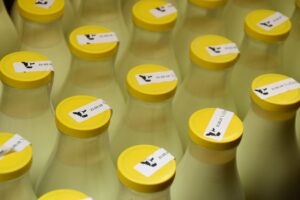
Bringing detailed nutritional labelling to raw foods like meat is the new frontier for the food sector. The retailers who lead the way will have a massive competitive advantage in the new, tech enabled world.
Food labelling is an intrinsic part of the packaged food industry, and increasingly requires highly detailed information. As well as the actual ingredients and their nutritional value, labels can include the country of origin, whether the food is organic, non-organic or free-range, if it’s halal or kosher, any allergens, dates of durability, and more. This data helps consumers make conscious purchasing decisions based on their dietary, health, and cultural requirements.
Today, technology and recipe management systems enable industrial scale, accurate labelling of packaged food to comply with current legislation and food safety guidelines. The next step in the journey of food transparency is standards and technology that can accurately measure the nutritional value of fresh produce as well, including lamb and beef, and display these details on the label along with the country of origin, weight, and price.
The benefits for food retailers
The demand for labelling is being driven by consumers. People increasingly expect information on food provenance to make more conscious purchasing decisions. Movements such as slow food, Fair Trade and growing awareness of the social and environmental impact of food production and transportation are making consumers care about how the food on their table was produced, as well as its journey.
For food producers and retailers, it’s not just about complying with legislation. It’s about taking it a level further and winning hearts and minds. Consumers will vote with their feet. Poor practices not only make news headlines but are shared rapidly over social media.
Prescriptive health management is also closely looking into how fresh food contributes to how nutrition can prevent, manage and treat illness. The BMJ’s Food for Thought 2020 collection of reports addresses issues such as what role the commercial food system should play in promoting health through better diet, and whether nutrition can support healthy cognitive ageing and reduce dementia risk.
The result is that people are much more aware of food origin. There is increasing research into the correlation between where and how animals are reared and the nutritional value and quality of the meat they produce. It’s no longer about the “cheapest chicken” but the tastiest and most nutritional foods.
As a result, accurate labelling can be a significant competitive advantage for food retailers. As consumer understanding of general nutrition continues to grow, they will seek out highest-quality food based on trusted information as well as understanding of provenance.
The road to fresh food labelling
A key question is what needs to happen at a granular level for the industry to include nutritional value food labels on fresh produce?
One of the most important steps in enabling better labelling for fresh food is to have greater technology adoption and collaboration throughout the supply chain, from R&D through production and transportation, to the end retailer. Everyone, from producers, processors and industry governing bodies to retailers, supermarket chains and others need to agree on common standards.
Having more transparency, being able to make a more informed purchase, and knowing that a retailer supports high-quality food all build trust and loyalty. If we can get to a point where a consumer looking at a steak in a supermarket is able to know the precise amount of grams of protein, Omega3 acids, iron, vitamin B12, and additional nutritional information about that cut of meat, and be confident that it came from a sustainable and ethical producer, it will unlock a new and more powerful relationship between the consumer and the retailer.
By Remo Carbone, CEO at MEQ Probe
This article was first published by Inside Retail
